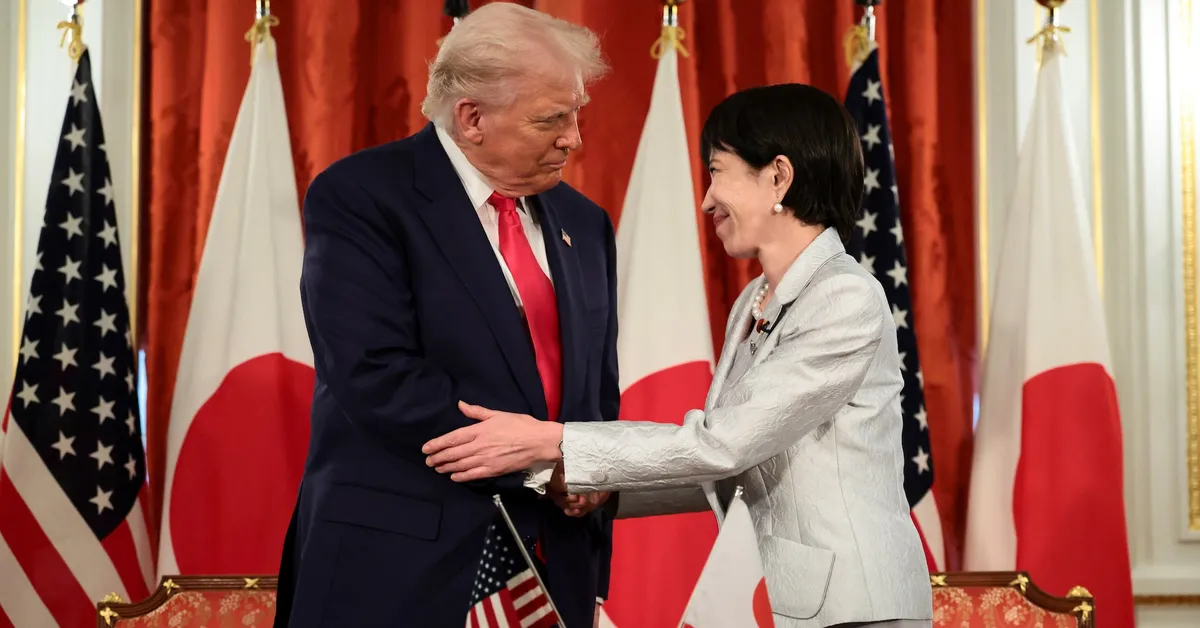
On October 28, 2023, U.S. President Donald Trump and Japanese Prime Minister Sanae Takaichi formalized a significant framework agreement aimed at securing the supply of rare earths. This strategic partnership is designed to mitigate China's overwhelming dominance in the production of essential electronic components. The signing ceremony took place at the opulent Akasaka Palace in Tokyo, characterized by its neo-Baroque architecture and stunning chandeliers adorned with gold decorations, as aides looked on in approval.
While no direct references to China were made during the signing, both leaders are acutely aware of the country's control over more than 90% of the global rare earth processing market. This has raised alarms regarding the stability of the mineral supply chain for both nations, especially in light of recent export restrictions imposed by Beijing. In a related development, Trump is scheduled to meet with Chinese President Xi Jinping on Thursday during the Asia-Pacific Economic Cooperation summit in South Korea, where they are expected to discuss potential agreements to halt the escalation of U.S. tariffs and Chinese export controls on rare earths.
The agreement highlights Japan and the U.S.'s commitment to leveraging economic policy tools and coordinated investments to expedite the development of diversified and equitable markets for critical minerals and rare earths. According to a statement from the White House, both countries aim to provide financial support to selected projects within the next six months. Additionally, discussions are underway to establish a mutually beneficial stockpiling arrangement, collaborating with other international partners to reinforce supply chain security.
Despite China's dominance, the U.S. and Myanmar account for 12% and 8% of global rare earth extraction, respectively, while Malaysia and Vietnam contribute 4% and 1% of processing. These figures underscore the necessity for strategic alliances in the rare earth sector to secure a stable supply chain.
As part of a broader bilateral trade agreement, Japan has pledged a substantial $550 billion investment into the U.S. economy, which may encompass various sectors, including power generation and liquefied natural gas (LNG). Notably, JERA, Japan's largest LNG buyer, has committed to purchasing up to 5.5 million metric tons of U.S. LNG per year under long-term contracts, with deliveries anticipated to commence around 2030. This volume is approximately equivalent to Japan's current annual imports from the Sakhalin-2 project.
Japan currently relies on Sakhalin-2 for about 9% of its gas needs, but most of this supply is set to conclude between 2028 and 2033. While Japan imports less than 1% of its oil from Russia under a sanctions waiver, the majority of its oil needs are satisfied through supplies from the Middle East. Furthermore, JERA's recent investment of $1.5 billion in gas assets in Louisiana marks its entry into upstream production in the U.S., joining Tokyo Gas and Mitsui in the market.
To maintain stable electricity prices, Japan is keen to continue its LNG imports from Sakhalin-2. A senior official indicated that the delivery time for LNG from Sakhalin-2 is significantly shorter—only a few days—compared to approximately a week from Alaska and up to a month from the U.S. Gulf Coast. The U.S. administration has expressed a desire for Japan to cease importing Russian energy, yet the proximity and cost-effectiveness of Sakhalin-2 make it a challenging alternative. As noted by Nobuo Tanaka, CEO of Tanaka Global, Inc., the pressing question remains: Can the U.S. provide LNG to Japan at prices comparable to those from Russia? Can gas from Alaska be as affordable?
This agreement marks a pivotal moment in U.S.-Japan relations as both nations work together to secure their mineral and energy supplies in an increasingly competitive global landscape.